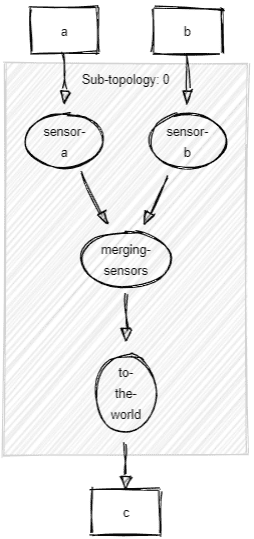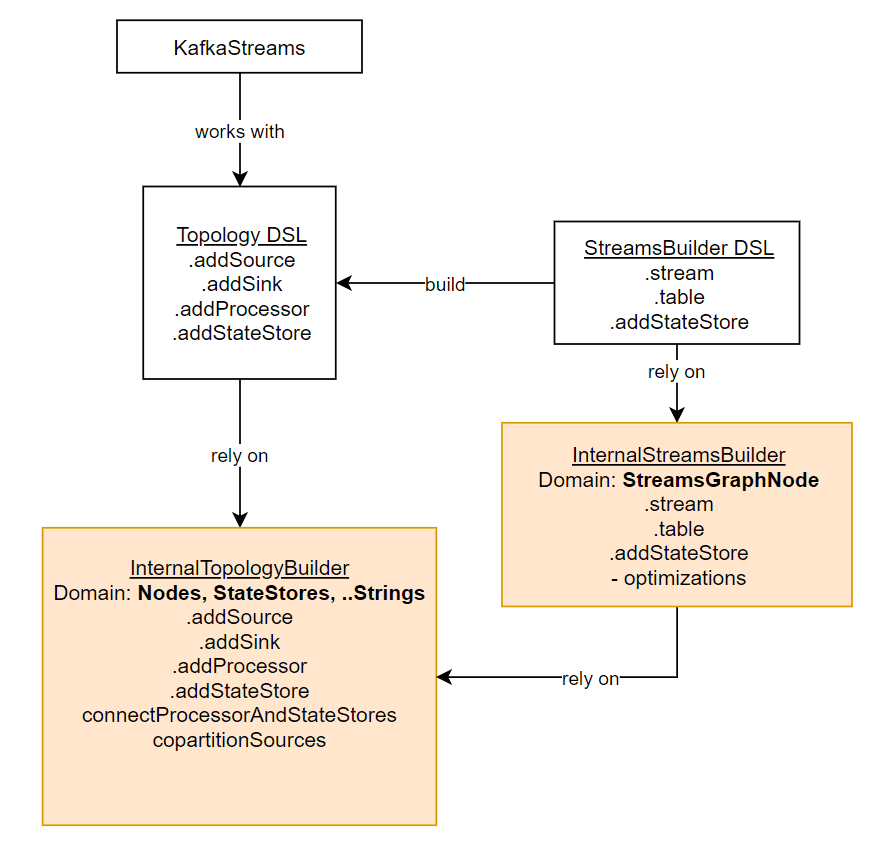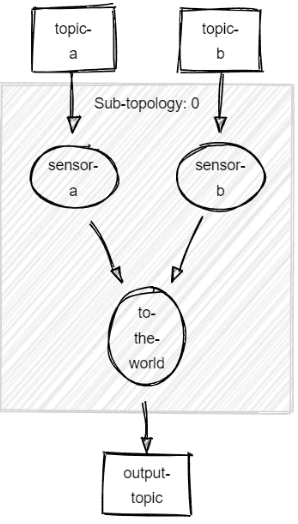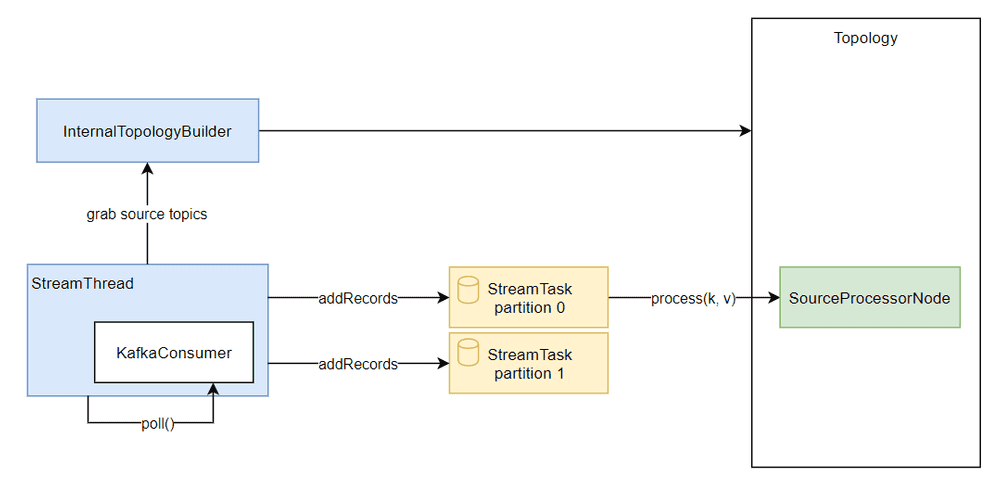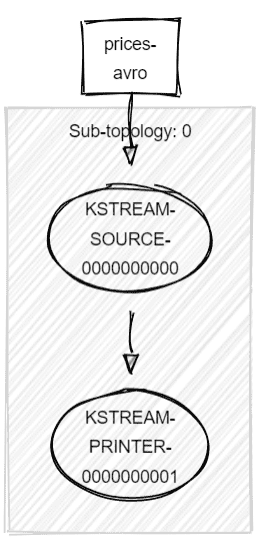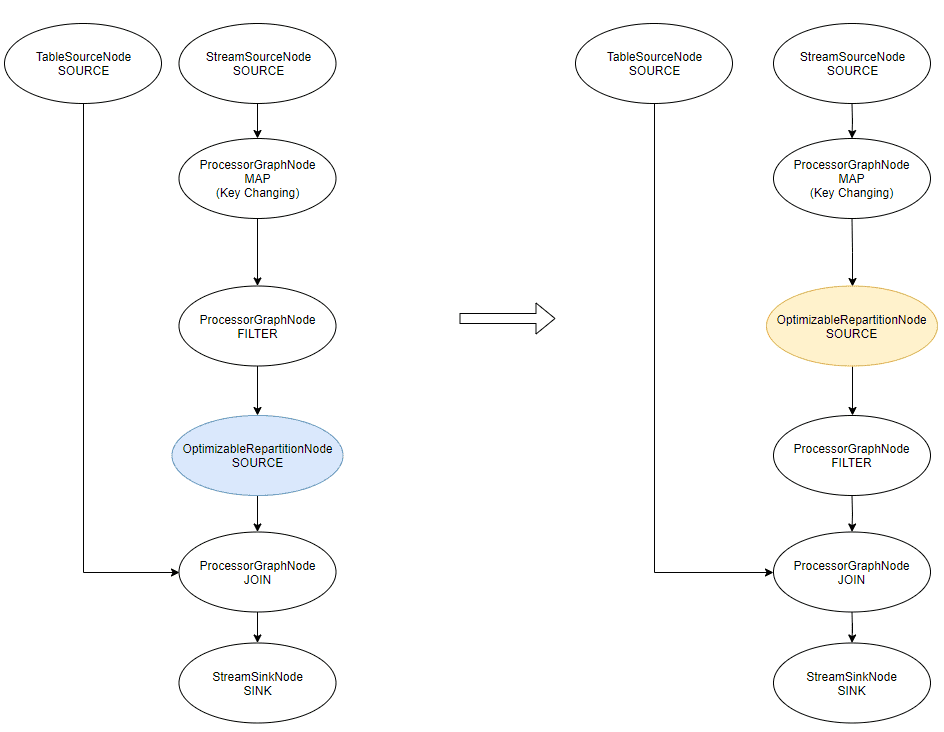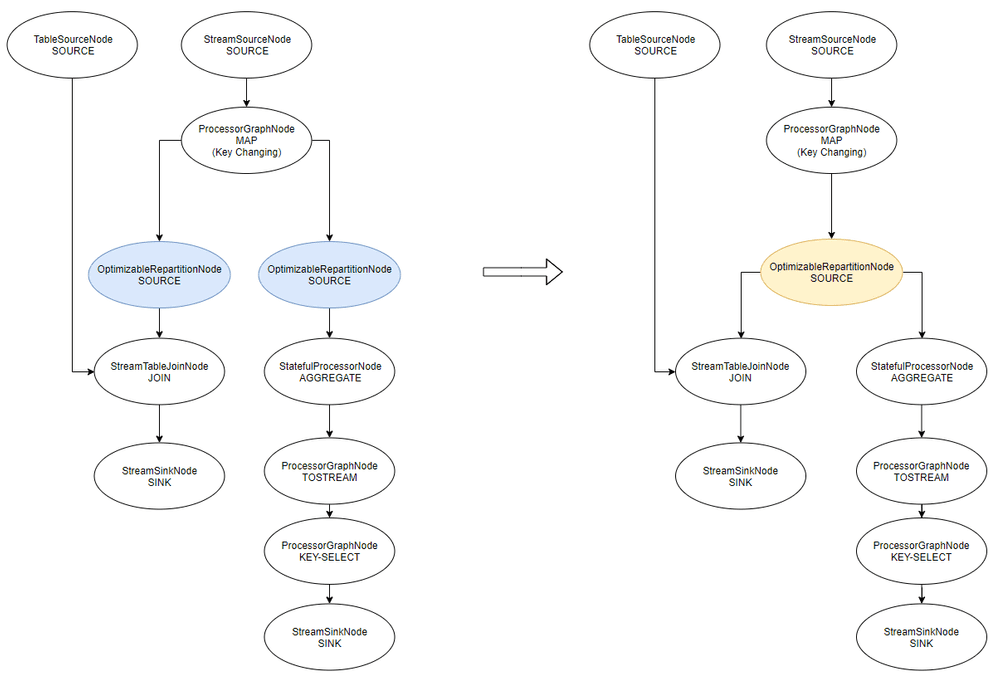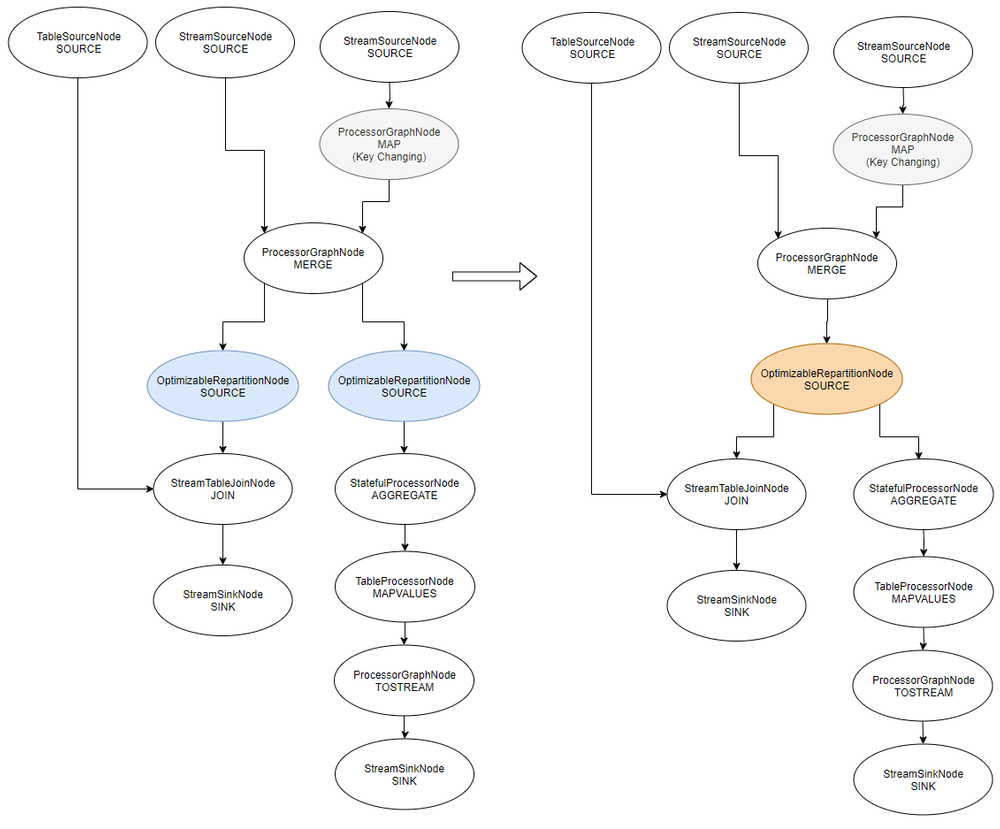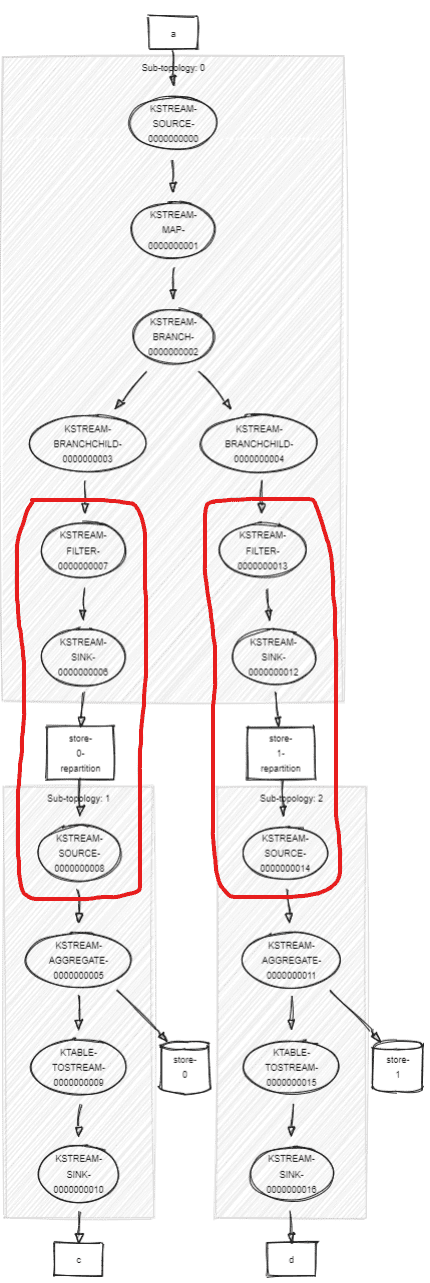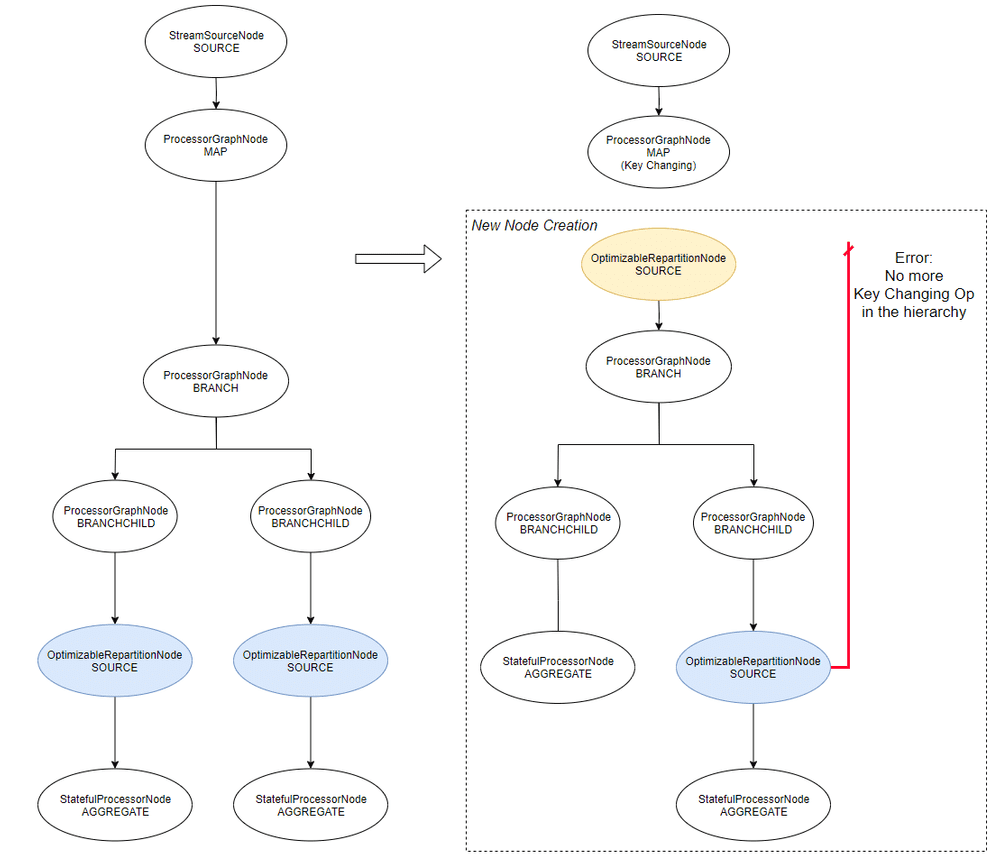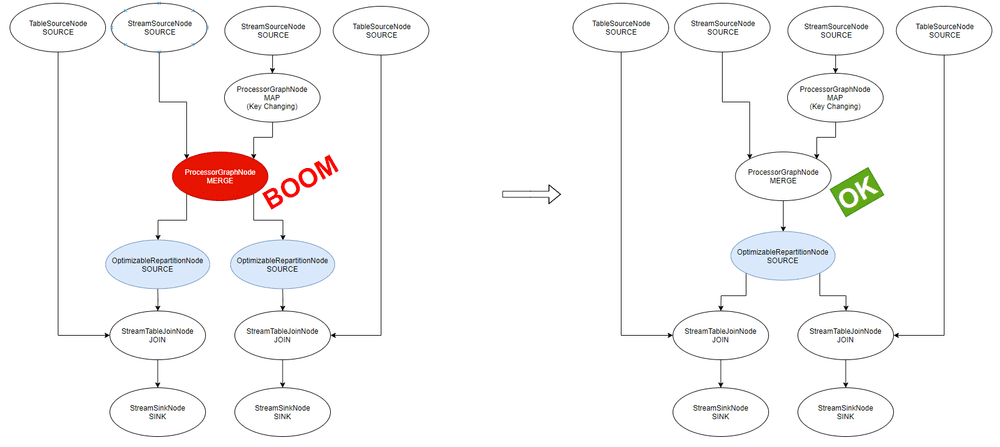Working on an event-sourcing based project, we are processing different sources of events with many KStreams in the same application. We wanted to put the results of all of them in the same topic, still running a unique application and a single KafkaStreams. Of course I forgot about merge(), so I was wondering how would we do it.
This lead me to learn more about the Processors and the Optimizations in Kafka Streams which is what I talk about here. I’ll sprinkle that with best practices and things-to-be-aware-of.
A good blog about the optimizations in Kafka Streams is available on Confluent, by its authors: https://www.confluent.io/blog/optimizing-kafka-streams-applications
Summary
Merge
Without merge()
How would we do it?
It can’t be a simple join. Maybe it could be an outer-join? As soon as one value (left or right) appears, the outer-join is triggered and send either (A, null), (null, B) or (A, B). But if there is really a join, or a duplicate, how do I know if I have already sent the left, the right, or none (and avoid duplicates)? I could have some correlation and a state somewhere to identity and remove duplicates.. Wow, it’s getting complicated!
Hopefully, merge() exists.
With merge() and bonus
merge is a stateless operator. It _merge_s 2 streams into one, with no particular ordering, it’s not deterministic, it’s not “one after the other”.
There is no synchronization between the 2 streams, one can never emit any event, it won’t stop the merge to happen.
Note: in all the code examples, I simplify and don’t display the serde parameters, it won’t compile.
sb.stream("a")
.merge(sb.stream("b"))
.to("c")Already, we can mess-up with Kafka Streams:
// are we getting duplication of "a" in "c" ?
val input = sb.stream("a")
input.merge(input) // we reuse the reference
.to("c")It doesn’t work as expect: no duplication of data (not sure if this is expected (no) or a bug!).
If we check the Topology, we can see our merge has only one source instead of 2 (it’s a merge!):
Topologies:
Sub-topology: 0
Source: KSTREAM-SOURCE-0000000000 (topics: [a])
--> KSTREAM-MERGE-0000000001
Processor: KSTREAM-MERGE-0000000001 (stores: [])
--> KSTREAM-SINK-0000000002
<-- KSTREAM-SOURCE-0000000000
Sink: KSTREAM-SINK-0000000002 (topic: c)
<-- KSTREAM-MERGE-0000000001Compared to a real merge with 2 sources (2 different topics):
Topologies:
Sub-topology: 0
Source: KSTREAM-SOURCE-0000000000 (topics: [a])
--> KSTREAM-MERGE-0000000002
Source: KSTREAM-SOURCE-0000000001 (topics: [b])
--> KSTREAM-MERGE-0000000002
Processor: KSTREAM-MERGE-0000000002 (stores: [])
--> KSTREAM-SINK-0000000003
<-- KSTREAM-SOURCE-0000000000, KSTREAM-SOURCE-0000000001
Sink: KSTREAM-SINK-0000000003 (topic: c)
<-- KSTREAM-MERGE-0000000002Good practices
Before going back Kafka Streams merge(), Topology and optimizations, let’s take a detour about FP principles.
Beware of the Referential Transparency
Be aware that Kafka Streams is:
- not immutable-friendly: it alters the structures behind the scene.
- not referentially-transparent: we can’t just replace a variable by its value, the behavior will change.
This can lead to some surprises, a different behavior after refactoring, or runtime exceptions.
Consider our previous example, and inline the variable input:
val input = sb.stream("a")
input.merge(input).to("c")
// replace `input` by its value, a simple refactoring (think bigger for real use-cases):
sb.stream("a").merge(sb.stream("a")).to("c")This will crash at runtime:
TopologyException: Invalid topology: Topic prices has already been registered by another source.This is not the only place where referential-transparency doesn’t work.
It’s the same with all the *Supplier variants that must return a unique instance.
We can’t refactor without thinking about what we are doing, because we may alter the behavior of our program.
Doing so:
DeduplicationTransformer<> transformer = new DeduplicationTransformer(...);
stream.transform(() -> transformer, ...)We get this error at runtime (!):
Failed to process stream task 0_0 due to the following error:
java.lang.IllegalStateException: This should not happen as timestamp()
should only be called while a record is processedWhereas with the inline version, it works:
stream.transform(() -> new DeduplicationTransformer<>(...), ...)About immutability, each call to .filter, .map etc. mutates the Topology behind. We are getting a new reference to a KStream, but all the KStreams share the same Topology behind. We can’t neither use the same StreamsBuilder to build different topologies, because it also references the same Topology.
Naming the processors
When we work with Kafka Streams, we are getting used to capital names “KSTREAM-SOURCE-000000042”, “KSTREAM-MERGE-00000001337” but we can make it easier for us.
When we look at a Topology, instead of having unhelpful source, processor, and sink names, it’s better to name them.
It’s the concept of the Consumed, Produced, Grouped, Joined, Printed, Suppressed instances: to name and configure the operators hidden behind the DSL.
Topologies:
Sub-topology: 0
Source: KSTREAM-SOURCE-0000000000 (topics: [a])
--> KSTREAM-MERGE-0000000002
Source: KSTREAM-SOURCE-0000000001 (topics: [b])
--> KSTREAM-MERGE-0000000002
Processor: KSTREAM-MERGE-0000000002 (stores: [])
--> KSTREAM-SINK-0000000003
<-- KSTREAM-SOURCE-0000000000, KSTREAM-SOURCE-0000000001
Sink: KSTREAM-SINK-0000000003 (topic: c)
<-- KSTREAM-MERGE-0000000002To
Topologies:
Sub-topology: 0
Source: sensor-a (topics: [a])
--> merging-sensors
Source: sensor-b (topics: [b])
--> merging-sensors
Processor: merging-sensors (stores: [])
--> to-the-world
<-- sensor-a, sensor-b
Sink: to-the-world (topic: c)
<-- merging-sensorsFor merge, map*, *transform*, join* etc., in 2.3 it’s not yet possible to assign a custom name to the processors. The work has been done, but not yet released. A new Named parameters will show up to customize them. See KIP-307.
The Processor API
Link between KafkaStreams, StreamsBuilder, Topology
Before diving into the Processor API, let’s talk about the low-level DSL versus high-level DSL.
Here is an simple object diagram of the link between our friends:
- Kafka Streams runs a
Topology. - When we don’t use the high-level DSL, we directly build a
Topology(the physical plan, that’s exactly what Kafka Streams will run) that forwards calls to aInternalTopologyBuilder: this is the latter that contains all the data about the real topology underneath. - When we use the high-level DSL, we pass through the
StreamsBuilder(the Logical Plan, that’s going to be converted to a physical plan) that forwards calls to aInternalStreamsBuilder. When we ask tobuild()the StreamsBuilder, it converts its abstraction to aTopology. - A
Topologytalks about Nodes, Processors, StateStores and Strings (to link Nodes children/parent by name). - A
Streamsis more abstract and talks about StreamsGraphNodes. OneStreamsGraphNodecan generate multiple Nodes and StateStores.
This abstraction allows Kafka Streams (the StreamsBuilder) to optimize what it’s going to generate as Topology. The StreamsGraphNodes expose a lot of metadata for the optimizer to be able to optimize (move, merge, delete, replace) locally or globally the StreamsGraphNodes (without altering the behavior), before converting it to a Topology (which is dumb).
A manual merge()
Back to our merge, we can do something simple using the Processor API:
val t = Topology()
t.addSource( // i'm using all the options, for the sake of it
Topology.AutoOffsetReset.EARLIEST,
"sensor-a", // its name
WallclockTimestampExtractor(),
Serdes.String().deserializer(), // only the deser, no Serde here
Serdes.String().deserializer(), // only the deser, no Serde here
"topic-a"
)
t.addSource(
Topology.AutoOffsetReset.EARLIEST,
"sensor-b", // its name
WallclockTimestampExtractor(),
Serdes.String().deserializer(), // only the deser, no Serde here
Serdes.String().deserializer(), // only the deser, no Serde here
"topic-b"
)
t.addSink(
"to-the-world", // its name
"output-topic",
Serdes.String().serializer(), // only the ser, no Serde here
Serdes.String().serializer(), // only the ser, no Serde here
StreamPartitioner { topic, k: String, v: String, par -> Random.nextInt() % par },
"sensor-a", "sensor-b" // its parent
)Topologies:
Sub-topology: 0
Source: sensor-a (topics: [topic-a])
--> to-the-world
Source: sensor-b (topics: [topic-b])
--> to-the-world
Sink: to-the-world (topic: output-topic)
<-- sensor-a, sensor-bIf we look carefully, we’ll notice we don’t even have a Processor in there! (nit: actually the Source and Sink are ProcessorNodes) We had one when we were using the high-level DSL “KSTREAM-MERGE” (it was just a passthrough). Thanks to the Processor API, we can plug directly multiples Sources to a Sink.
This is probably something that can be automatically optimized away when optimizations are on (it does not do it right now).
This lead to the question: which optimizations are possible, are going to be possible, and how Kafka Streams finds them?
StreamThreads & Backpressure
Do you know you can run Kafka Streams without Sink?
Unlike many streaming systems, Kafka Streams does not need to handle backpressure while processing. The only existing backpressure is outside of the Topology: it’s the StreamThreads that each manage a KafkaConsumer. This one has subscribed to the source topics (it has access to the Topology) and is often poll() to get the data.
The records are bufferized and sent downstream (to the StreamTasks), one by one for processing: Kafka Streams has a depth-first approach. It’s a push-based approach. The entire graph is traversed before another record is forwarded through the topology. There are no buffers between operators.
Kafka Streams tries to fill its in-memory buffers from the poll() data (without committing offsets of course, until processing). If a partition buffer is full (slow processing) or if some topics are consumed way faster than other, then Kafka Streams will pause() (KafkaConsumer API) some partitions, to keep everyone on the same page (same time). This is the only place where there is some backpressure. If some error occurs in the stream processing, because the data are backed by Kafka, Kafka Streams will resume to the latest committed offset of the source topics.
A Breadth-First approach will probably be worked on later in Kafka Streams, to allow for parallel processing. For instance, if doing IOs in a Streams, it’s better to parallelize processing. It’s naturally done at the partition level right now thanks to the Kafka partitionning model, but it could be finer. Check out KAFKA-6034.
In reactive streams programming, operators tell their need/capability to their parents, to ensure they won’t overflow, and the ask (consolidated by all other operators across) goes upstream until it reaches the sources. There, data are pushed or pulled upon demand when downstream is ready to accept more. The strategy of pull/push can vary over time (“I know you will ask me for more data soon, so I will directly push data to you from now on. But if you struggle with, I’ll stop pushing and you’ll go back to pull me data.”), but that’s another story.
All that to say that’s why we can have working topologies without sinks in Kafka Streams: data are pushed, and nobody is asking for more.
sb.stream("a").print(Printed.toSysOut())Note that offsets will be properly committed to Kafka. So when we say Kafka Streams is only for process “reading from topics and writing to topics”, it’s not entirely true. We can query webservices, save data into databases etc. without ever having to sink into a topic.
It’s not the right use-case. Doing so won’t ensure exactly-once processing with the external systems (ensure there are idempotent!) because they are outside of Kafka scope, and we won’t have a trace of our processing. This is why Kafka Connect exist.
From Logical Plan To Optimized Logical Plan
Using the Processor API, we optimized right away our topology. But we’re humans, we can miss optimizations or do worse.
How to enjoy optimizations?
Kafka Streams won’t optimize our Topology if we go straight to the low-level API. Optimizations are only enabled when writing with the high-level DSL.
Optimization must be enabled when we build() the Topology, not in the general KafkaStreams config, otherwise that won’t do a thing.
val sb = StreamsBuilder()
// ...
val topo = sb.build(Properties().apply {
put(StreamsConfig.TOPOLOGY_OPTIMIZATION, StreamsConfig.OPTIMIZE)
})Every call to the high-level DSLs creates a StreamsGraphNode and adds different metadata, according to the function called, to the state of the parents etc.
For instance, when we do a merge(), this adds a StreamsGraphNode to the Logical Plan, whose parents are the 2 original incoming KStreams StreamsGraphNodes. It also flags this new node as a mergeNode and as repartitionRequired if one of the original incoming KStreams already required repartitioning. When we to build the Topology, each merge node is going to be converted to a Processor with 2 parents, that will let data pass through (to its child).
Before that, Kafka Streams will try to optimize its Logical Plan (the StreamsGraphNodes) before building the Physical Plan (the Processors). To do this, it relies on the metadata we’re talking about.
StreamsBuilder to Topology
When we .build() our StreamsBuilder, the first thing it does is check if the optimization are opt-in. If that’s the case, it optimizes the graph of StreamsGraphNode to a new graph of StreamsGraphNode (actually, it mutates it). Then it can build the low level Topology. To do so, it iterates over all the ordered nodes and ask them to writeToTopology.
There are 2 kinds of optimizations:
- KTable Source Topics: don’t always build a
-changelogtopic if it can reuse the source topic, to avoid duplicating the source topic. - Repartition Operations: this is the meat. This will try to prevent repartitioning multiple times the same topic.
1. Source Topics as Changelog
A KTable is not always backed by a -changelog topic. Example:
sb.table("a")
.toStream()
.to("b")In this case, it will forward all non-null-keys records downstream (a KTable ignores null keys), and no statestore will be created:
Another example:
sb.stream("a")
.join(sb.table("b")) { a, b -> b }
.to("c")Without optimization, this will generate a -changelog topic to keep the state (latest value by key) of b, whereas with optimization, no -changelog will be created.
The optimizer makes KTables reuse source topics if they can, instead of always building their own changelog topic. Still, we have to ensure the source topic has a compact strategy (it’s the default for the -changelog topics) otherwise the restauration into the local state (RocksDB) can take a while (if we have 10M records, but only with 100 distinct keys: it’s going to consume 10M records instead of 100).
Without optimizations enabled, it’s still possible to avoid generating a -changelog topic when creating a KTable:
sb.table("topic", Materialized.with(Serdes.String(), Serdes.String())
.withLoggingDisabled())2. Key Changing & Repartition Required Operations
When we use selectKey, map, flatMap, transform, flatTransform or groupBy(KeyValueMapper) (does a selectKey), the resulting KStream is always flagged as repartitionRequired, and the underneath StreamsGraphNode is marked as keyChanging (KStream is an abstraction over the Logical Plan, the StreamsGraphNodes).
repartitionRequired on the KStream is used to mark the downstream KStreams that they belong to a graph where repartition is required by some parent. keyChanging will be used by the optimizer (it works with StreamsGraphNodes, not with KStream which is only a DSL-abstraction for humans).
through() and all kinds of *join() (if repartitionRequired) will stop the propagation of repartitionRequired, because they will sink the data into a topic. Hence, no repartition is needed after them: it has been materialized and this will form a new sub-topology.
For example, when joining:
- KStream + KStream: this will create a
-left-repartitionand/or-right-repartitiontopics if the upstream KStreams are flagged asrepartitionRequired(we should use aJoinedto get a nice name). These topics will be the real sources of data for the join.
// this creates the "applicationId-keeping-only-b-left-repartition" topic
sb.stream("a")
.map { k, v -> KeyValue.pair(k, v) }
.leftJoin(sb.stream("b"), { a, b -> b }, JoinWindows.of(1000), Joined.`as`("keeping-only-b"))
.to("c")- KStream + KTable: this will create a
-repartitiontopic if the KStream is flagged asrepartitionRequired. This topic will be the real source for the join.
The Optim1zer
Let’s dive a bit more into the repartition optimization, which is the biggest piece.
The OptimizableRepartitionNode
The optimizer works by finding and creating/replacing OptimizableRepartitionNodes.
Such nodes are created when the current KStream is flagged repartitionRequired by the upstream and when we do:
- an aggregation:
reduce(..),aggregate(..),count()(aftergroupBy*(..)orwindowedBy(..)) - a
*join()with KStream/KTable
When built, a OptimizableRepartitionNode adds multiple things to the Topology:
- an internal repartition topic
t - a Processor
Pto filternullkeys (not forwarded downstream) - a Sink to the repartition topic
twithPas parent - a Source from the repartition topic
t
In short, it hides the repartition logic. Below in red, the four elements:
Each OptimizableRepartitionNode creates a new sub-topology, because we pass through a new topic.
Visualizing the Logical Plan: before and after
Now that we know what is a OptimizableRepartitionNode, let’s visualize them.
Those structures are private in the code, it’s different than what we get when we .describe() a Topology, which is the physical plan. Here, we’re talking about the Logical Plan.
Let’s make Kafka Streams optimize our Logical Plan, by doing a map() (keyChanging operation) and a join():
sb.stream("a")
.map { k, v -> KeyValue.pair(k, v) }
.join(sb.table("b")) { a, b -> b }
.to("c")As we said, we can see an OptimizableRepartitionNode. But unfortunately, that’s not enough any optimization to kick-in. The high-level graph topology is this:
root ()
KSTREAM-SOURCE-0000000000 (StreamSourceNode)
KSTREAM-MAP-0000000001 (ProcessorGraphNode)
KSTREAM-SOURCE-0000000007 (OptimizableRepartitionNode)
KSTREAM-JOIN-0000000008 (StreamTableJoinNode)
KSTREAM-SINK-0000000009 (StreamSinkNode)
KTABLE-SOURCE-0000000004 (TableSourceNode)After “optimization”, the OptimizableRepartitionNode will be replaced by another OptimizableRepartitionNode and that’s it. No changes. No gain. It’s an edge case that probably could be optimized (useless). Let’s go deeper.
Our First (De-)Optimization
What if we add a filter() after our map()?
sb.stream("a")
.map { k, v -> KeyValue.pair(k, v) }
.filter { k, v -> false } // don't let pass anything!
.join(sb.table("b")) { x, y -> y }
.to("c")An “optimization” will kick in:
- Before:
KSTREAM-SOURCE-0000000000 (StreamSourceNode)
KSTREAM-MAP-0000000001 (ProcessorGraphNode)
KSTREAM-FILTER-0000000002 (ProcessorGraphNode)
KSTREAM-SOURCE-0000000008 (OptimizableRepartitionNode)
KSTREAM-JOIN-0000000009 (StreamTableJoinNode)
KSTREAM-SINK-0000000010 (StreamSinkNode)
KTABLE-SOURCE-0000000005 (TableSourceNode)- After:
KSTREAM-SOURCE-0000000000 (StreamSourceNode)
KSTREAM-MAP-0000000001 (ProcessorGraphNode)
KSTREAM-SOURCE-0000000013 (OptimizableRepartitionNode)
KSTREAM-FILTER-0000000002 (ProcessorGraphNode)
KSTREAM-JOIN-0000000009 (StreamTableJoinNode)
KSTREAM-SINK-0000000010 (StreamSinkNode)
KTABLE-SOURCE-0000000005 (TableSourceNode)Did you see what changed? The FILTER is not at the same place, and the OptimizableRepartitionNode is a new Node (id changed).
Post-optimization, the FILTER is the child of the OptimizableRepartitionNode instead of being its parent. It means the OptimizableRepartitionNode is written in the Topology before our filter. (nit: each node has actually a priority to determine the order of writing)
Looking at the Topology makes more sense:
In the second version, “optimized”, the filter is executed after the repartition logic.
Unfortunately, this means the repartition topic will contain MORE data than with the unoptimized version. Not good. Especially in my extreme case here, where my filter was a plain “don’t let pass anything (.filter { k, v -> false })”, my repartition topic will actually contain everything instead of nothing.
We should always analyze our topology no matter if we use optimizations or not.
What’s the point of this optimization therefore? What I described here is not an optimization. But if we look at the global picture, it’s more nuanced.
Source Topics as Changelogs revisited
I’ve started the same streams with and without optimization. Right after the start of the streams, if we look in Conduktor, we get this:
We wait a bit then refresh:
A few points here:
ctopic is empty because we filter out all records (.filter { k, v -> false }).-
In the unoptimized version
- we have 2 internal topics
- The repartition topic is always empty (thanks to our
filter()). - The changelog topic contains 200 records, which is the number of distinct keys of
a
-
In the optimized version
- we have only 1 internal topic: the KTable can reuse its source topic
bif it needs to rebuild its local state - This means it needs to consume 5,209 records to find out there are only 200 distinct keys
- The repartition topic contains everything unfiltered at first (5,209), then is purged by Kafka Streams (because it knows it’s temporary data, it deletes them after committing; see KAFKA-6150 - Make Repartition Topics Transient).
- we have only 1 internal topic: the KTable can reuse its source topic
So, all in all, it’s not so bad. With optimizations, we avoid the creation of a topic, and the repartition-topic, albeit unfiltered, is quickly purged. Still, a filter() should always be executed before a map(). Let’s talk about Operator Selectivity & Reordering.
Operator Selectivity & Reordering
Operators have a selectivity.
map*have a selectivity of 1: 1 item in, 1 item out.filter*have a selectivity between0 ≤ s ≤ 1, it depends upon the filter.flatMap*and*transform*have an unknown selectivity. They can emit 0 or many items for one item in. But according to our use-case, we can know if it’s fixed or dynamic.
All that to say that when we do a map(..).filter(..), what we want is generally filter(..).map(..) because we’ll do less mapping with the second version, the selectivity of filter being generally less than 1: less records out.
It’s a possible optimization Kafka Streams can apply, known as Operator Reordering, but it’s not so straightforward.
- If
map(..)andfilter(..)works on the same typeA, then it’s possible to invert them. - If
map(..)takes aAand returns aBthen the code infilter(..)(was working onB) needs to be updated to work onA. We could call the samemap(..)to convertBtoAand letfilter(..)untouched, but that would defeat the purpose of the optimization.
Another dimension is the cost of the operators. If we know one operator has a large cost (like doing IO or massive computations) then it’s better to defer it the most we can, after other operator with a selectivity < 1 went through.
The Real Optimization
To see a clear value added to the repartition optimization, we need to complexify our topology to create 2 OptimizableRepartitionNodes that derive from the same repartitionRequired KStream:
// We build a `repartitionRequired` KStream
// -> map, selectKey, flatMap, transform, or flatTransform
val k = sb.stream("a").map { k, v -> KeyValue.pair(k, v) }
// Then we create 2 sub-graphs from this KStream
k.join(sb.table("b"), { x, y -> y }) // First OptimizableRepartitionNode
.to("c")
k.groupByKey()
.count() // Second OptimizableRepartitionNode
.toStream()
.to("d")The unoptimized Logical Plan looks like:
root
KSTREAM-SOURCE-0000000000 (StreamSourceNode)
KSTREAM-MAP-0000000001 (ProcessorGraphNode)
-> KSTREAM-SOURCE-0000000007 (OptimizableRepartitionNode)
KSTREAM-JOIN-0000000008 (StreamTableJoinNode)
KSTREAM-SINK-0000000009 (StreamSinkNode)
-> KSTREAM-SOURCE-0000000014 (OptimizableRepartitionNode)
KSTREAM-AGGREGATE-0000000011 (StatefulProcessorNode)
KTABLE-TOSTREAM-0000000015 (ProcessorGraphNode)
KSTREAM-KEY-SELECT-0000000016 (ProcessorGraphNode)
KSTREAM-SINK-0000000017 (StreamSinkNode)
KTABLE-SOURCE-0000000004 (TableSourceNode)The optimized Logical Plan looks like:
root
KSTREAM-SOURCE-0000000000 (StreamSourceNode)
KSTREAM-MAP-0000000001 (ProcessorGraphNode)
-> KSTREAM-SOURCE-0000000020 (OptimizableRepartitionNode)
KSTREAM-JOIN-0000000008 (StreamTableJoinNode)
KSTREAM-SINK-0000000009 (StreamSinkNode)
KSTREAM-AGGREGATE-0000000011 (StatefulProcessorNode)
KTABLE-TOSTREAM-0000000015 (ProcessorGraphNode)
KSTREAM-KEY-SELECT-0000000016 (ProcessorGraphNode)
KSTREAM-SINK-0000000017 (StreamSinkNode)
KTABLE-SOURCE-0000000004 (TableSourceNode)A picture is worth a thousand words (we won’t show the Physical Plan, no need):
If we look at our topics in Conduktor, we are happy to have optimized our topology:
- The unoptimized version has 2 repartition topics and 2 changelog topics (ktable and aggregate).
- The optimized version has 1 repartition topic and 1 changelog topic (the aggregate).
The 2 OptimizableRepartitionNode were “merged” and the new node replugged itself to the parent and the children of the old nodes. This is what the optimizer does. It prevents the topology to generate several repartition topic that will contain the same data.
Instead of having 3 sub-topologies, we only have 2 (one less repartition topic). Imagine on a real Kafka Streams application with multiple aggregations, computing different aggregations on the same KStream, doing several joins, the gain can be tremendous (less topics: less storage, mem, and IO) .
Reminder: we need a key-changing operation for the optimizations to occur. If we never selectKey, map, flatMap, transform, flatTransform or groupBy, no KStream will be marked as repartitionRequired, hence no OptimizableRepartitionNode will be created.
Value Change after a Key Change
There will prevent any optimizations:
val t = sb.stream("a")
.selectKey { k, v -> k }
.mapValues { k, v -> v }
// ... same as beforeBy adding a .mapValues (a value-changing operation) after the a key-changing operation, the optimization won’t apply.
I’m not entirely sure why. At first, this looks dumb anyway. If I do a key-changing followed by a value-changing operation, it means I need a map() or equivalent to do both at the same time. But in the grand scheme of things, where functions are everywhere, returning KStreams, this situation may happen (and could lead to an operator fusion optimization!).
Operations *mapValues() and *transformValues() are value-changing operations. We can just change the value of the record, this will prevent any repartitioning (because the key stays as-is). It’s a best practice to use them whenever possible.
Back to our merge()
Finally we’re back to our merge!
Let’s see how the optimizations work around a merge by looking at the Logical Plan before & after (the Physical Plan would be to painful to look at). (btw notice the end of this article: Limitations & Issues about merge())
val s1 = sb.stream("a")
val s2 = sb.stream("b").map{ k, v -> KeyValue.pair (k, v) }
val s3 = s1.merge(s2) // s3 becomes repartitionRequired because of s2
// both streams will their repartition logic
s3.join(sb.table("c"), { x, y -> y }).to("d")
s3.groupByKey().count().mapValues { k, v -> v.toString() }.toStream().to("e")Because our merge depends upon one repartitionRequired KStream (because of the map()), the whole merge is now repartitionRequired and will propagate downstream. This will create the two OptimizableRepartitionNodes we see (join() and count()).
Because the two repartition topics will contain exactly the same data (the source being the same), the optimizer will replace both by a unique one, and replug the graph around it.
The optimizer handles merge() in a specific way. If it wasn’t the case, the new OptimizableRepartitionNode would place itself after the MAP and before the MERGE, and that would totally mess up the Topology and results (I think).
Future Optimizations
Guozhang Wang added a lot of possible optimizations in KAFKA-6034 - Streams DSL to Processor Topology Translation Improvements mostly based upon Stream Processing Optimizations.
Below is a recap of what we can expect Kafka Streams will optimize in the future. But we shouldn’t wait for the implementations to be in Kafka Streams. According to our use-cases, we can already apply them manually. It’s just a bunch of generic or Kafka Streams specific patterns.
Operator Separation and Fission
To allow a better leveraging parallel processing power: split stream.map(f∘g) to stream.map(f).map(g), then we can support different needs of parallelism for f and g.
Start by splitting the operation:
Then apply a fission for f and/or g
This is what is done at the partition level in Kafka Streams thanks to Kafka, but it can be finer than that and work with multiple threads or fibers at the same time per partition.
Operator Fusion / Scheduling / Batching
Kafka Streams is using only the Depth-First strategy for now (one record traverse the whole topology at a time), but it could introduce the Breath-First strategy (which introduces some synchronization points):
- Send a batch of records to the first operator, then wait to collect
- Send its results to the second operator
- Meanwhile, send another batch of data to the first operator while the second is working on its own batch.
For IO heavy operations, it could break the operation into its own sub-topology with threads that can suspend / resume the IOs, as in the Fission optimization.
It’s a way to deal with async calls in a topology. For example, using Akka Streams:
Source(1 to 1000)
.mapAsync(20)(fetchFromDatabase)
.runWith(Sink.ignore)mapAsync takes a degree of acceptable parallelism and a function returning a Future. At any point in time, there are max 20 in-flight remote calls. The output order follows the input order (there is another operator mapAsyncUnordered, faster because it ignores ordering).
I’m not sure what it’s going to be in Kafka Streams, but I would love to see a mapAsync.
Redundancy Elimination
If the same operator doing the same thing appears several times, try to factorize it and broadcast the values downstream.
This is typically what is done with the key-changing operations that are reused:
The following is not optimized (map(f) generates two distinct operators doing the same thing):
val t = sb.stream("a")
val f = { key: String, value: String -> KeyValue.pair(key, value) }
t.map(f).filter { k, v -> false }.to("b")
t.map(f).filter { k, v -> true }.to("c")Multi-Join Operator Reordering
Re-order the join ordering based on join selectivity and cost, like the Operator Reordering optimization.
State Sharing / Join operator sharing
Share results of all s1.join(s2) in the code, like s1.join(s2).join(stream3) could reuse it.
Cogroup aggregations
KIP-150 - Cogroup: cogroup multiple aggregates
- into a new entity
CogroupedKStreamto reduce creation of unnecessary objects. (unfortunately in stand-by it seems)
Disable logging and reuse sink topic when changelog = sink topic
As raised in KAFKA-6035, when we build an aggregate and sink it directly, we’re going to create a -changelog topic that will contain exactly the data of the output topic:
sb.stream("a")
.groupByKey()
.aggregate({ ... }, { k, v, agg -> ... }, Materialized.`as`("hop").withCachingDisabled())
.toStream()
.to("b");No matter if we enable optimizations or not, we’ll find the same content in the -changelog topic and the out topic:
It would be useful to disable logging on this one and rely on the output topic to rebuild the state of the aggregation, to avoid creating redundant -changelog topics:
.aggregate({ ... }, { k, v, agg -> ... }, Materialized.`as`("hop").withLoggingDisabled())Limitations & Issues
Key Changing reference out of scope
I ran into a couple of issues enabling optimizations that prevented Kafka Streams from working. In this case, we must disable optimizations and optimize ourself. (and notify the Kafka Streams team)
For instance, if we take this branch example that aggregates each split (notice the map() to repartition data):
val f = { key: String, value: String -> KeyValue.pair(key, value) }
val p = Predicate<String, String> { k, _ -> k.length <= 7 }
val t = sb.stream("a").map(f).branch(p, p.not())
t[0].groupByKey().aggregate(...).toStream().to("b")
t[1].groupByKey().aggregate(...).toStream().to("c")The high-level graph is:
root
KSTREAM-SOURCE-0000000000 (StreamSourceNode)
KSTREAM-MAP-0000000001 (ProcessorGraphNode)
KSTREAM-BRANCH-0000000002 (ProcessorGraphNode)
KSTREAM-BRANCHCHILD-0000000003 (ProcessorGraphNode)
KSTREAM-SOURCE-0000000008 (OptimizableRepartitionNode)
KSTREAM-AGGREGATE-0000000005 (StatefulProcessorNode)
KTABLE-TOSTREAM-0000000009 (ProcessorGraphNode)
KSTREAM-SINK-0000000010 (StreamSinkNode)
KSTREAM-BRANCHCHILD-0000000004 (ProcessorGraphNode)
KSTREAM-SOURCE-0000000014 (OptimizableRepartitionNode)
KSTREAM-AGGREGATE-0000000011 (StatefulProcessorNode)
KTABLE-TOSTREAM-0000000015 (ProcessorGraphNode)
KSTREAM-SINK-0000000016 (StreamSinkNode)The generated Topology is: (OptimizableRepartitionNodes highlighted in red)
If we use StreamsConfig.OPTIMIZE, boom:
StreamsException: Found a null keyChangingChild node for OptimizableRepartitionNode
- StreamsGraphNode{nodeName='KSTREAM-SOURCE-0000000014', ...}
- BaseRepartitionNode {
... sinkName='KSTREAM-SINK-0000000012'
... sourceName='KSTREAM-SOURCE-0000000014'
... repartitionTopic='store-1-repartition'
... processor name='KSTREAM-FILTER-0000000013'What happens is this:
- Both
OptimizableRepartitionNodeare flagged for optimization - The first optimization occurs on the first branch, it builds a new
OptimizableRepartitionNode, unplug the children of the key-changing operation (map()) because it’s going to be the new child. - But before this, it tries to optimize the second branch and can’t find the key-changing operation (the
map()) because the new node is not plugged yet into the topology.
We can get the same error without branch, like in one of our previous example:
val k = sb.stream("a").map { k, v -> KeyValue.pair(k, v) }
.filter { k, v -> true } // BOOM! StreamsException: Found a null keyChangingChild
k.join(sb.table("b"), { x, y -> y }).to("c")
k.groupByKey().count().toStream().to("d")According to what we put between the keyChanging node and the OptimizableRepartitionNode children, we can get the error. I’m sure this error will soon be gone! :-) (this is 2.3)
merge() working only with optimization (!)
This one is funny because it works only if optimizations are enabled:
val s1 = sb.stream("a")
val s2 = sb.stream("b").map{ k, v -> KeyValue.pair (k, v) }
val s3 = s1.merge(s2) // s3 becomes repartitionRequired because of s2
// Then we generate 2 `OptimizableRepartitionNode` downstream
s3.join(sb.table("c"), { x, y -> y }).to("d")
s3.join(sb.table("d"), { x, y -> y }).to("f")Without “optimization”, the streams can’t run:
TopologyException: Invalid topology:
Topic KSTREAM-MERGE-0000000003-repartition has already been registered by another source.On the left, the unoptimized Logical Plan, on the right, after optimization (which runs):
Conclusion
I’ve started with my merge() thing and fell into the rabbit hole. It was a bit long but I hope you learned something!
Optimizations clearly reduce the load on our Kafka Cluster by avoiding to create unnecessary internal topics and simplify the Topology our Kafka Streams applications use. They improve performance and reduce memory/network pressure on our Kafka Streams applications: they will process less data and will avoid doing unnecessary or redundant operations to process our streams.
Despite a few subtleties (value-changing after key-changing) and exceptions we can get when starting the Kafka Streams application (they won’t make it into production anyway), we should always build our Topology with optimizations enabled. By upgrading our dependencies over time, more and more optimizations will be available without us to do anything.
We have to be careful because this can change the topology of the internal topics. Thus, a simple dependency upgrade can change which internal topic is used and maybe alter the behavior of the application if we are doing a rolling-upgrade. (Not sure of the impact and the strategy to adapt: big-bang release?).
Finally, as Kafka Streams developers, we should always check the Topology, to understand what’s going on, see what the Optimizations are doing, and check if we can make manual optimizations in this global picture.



